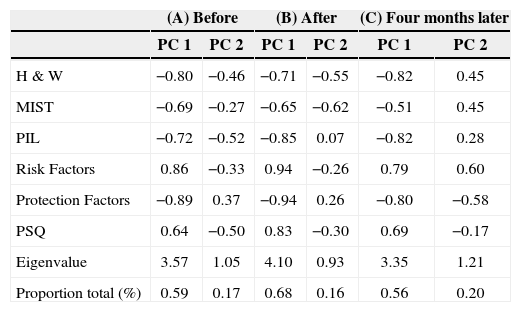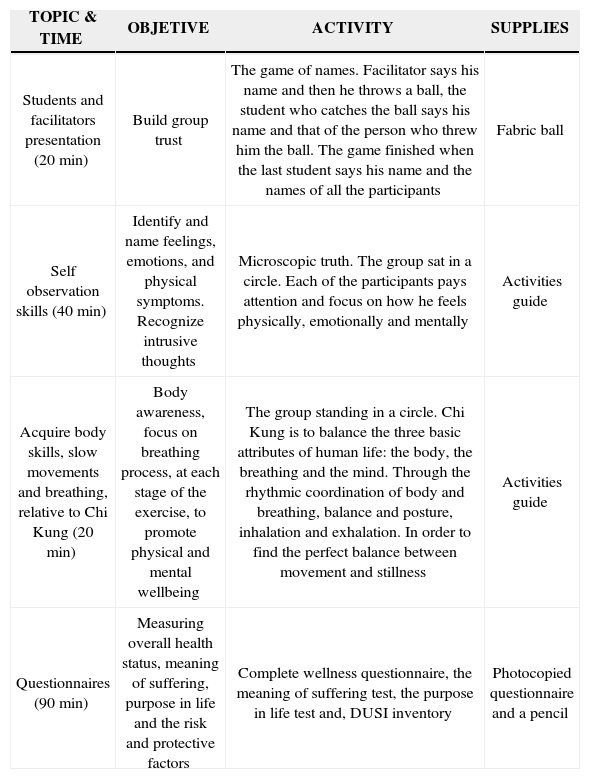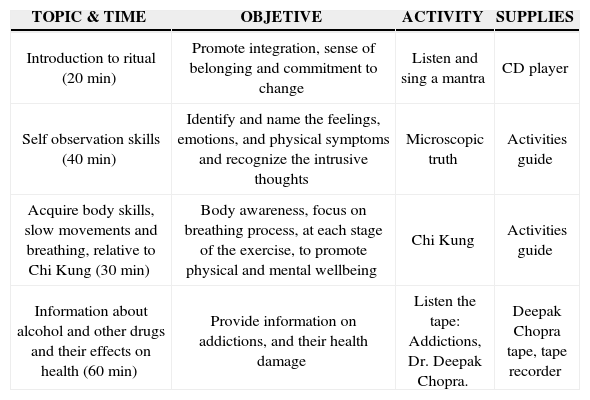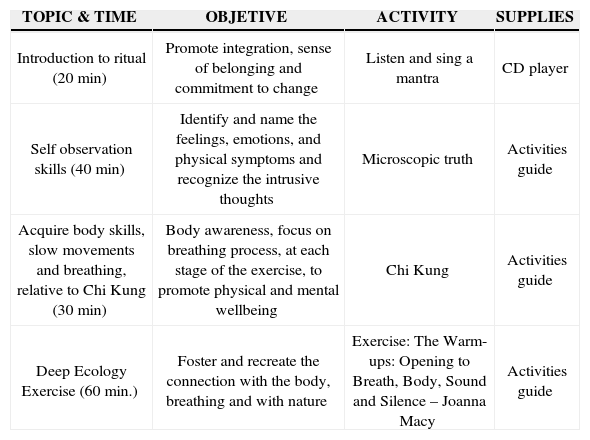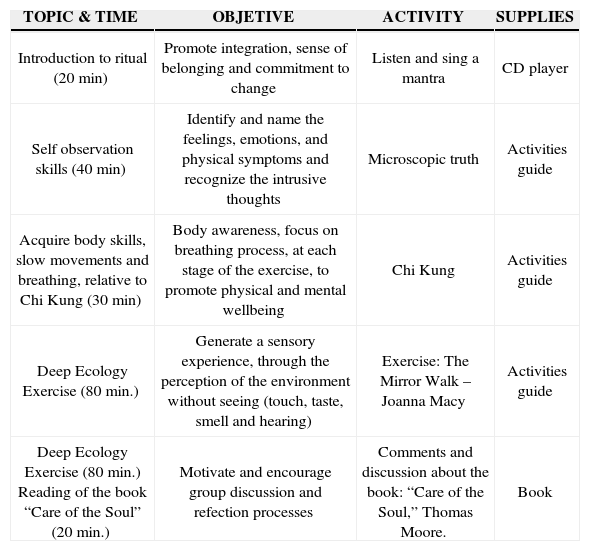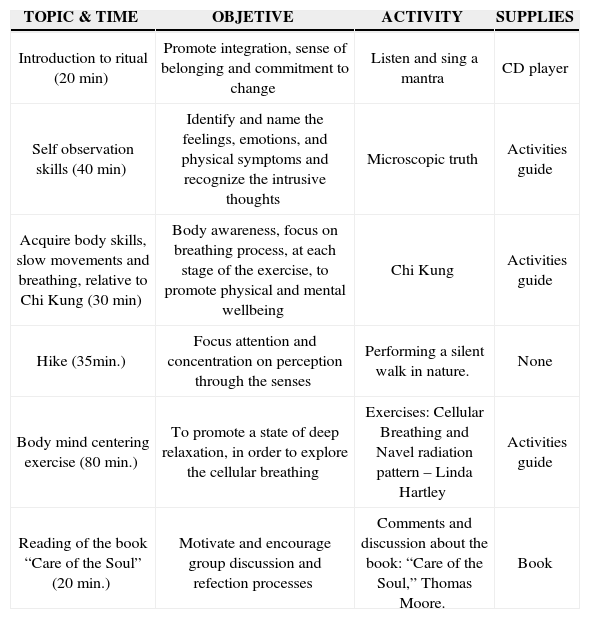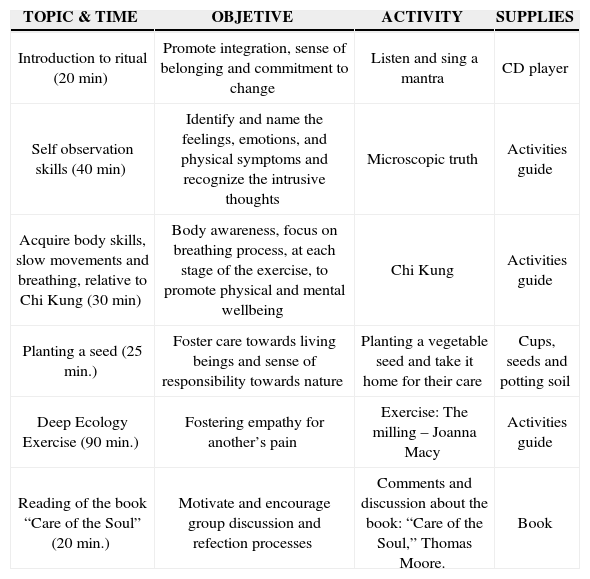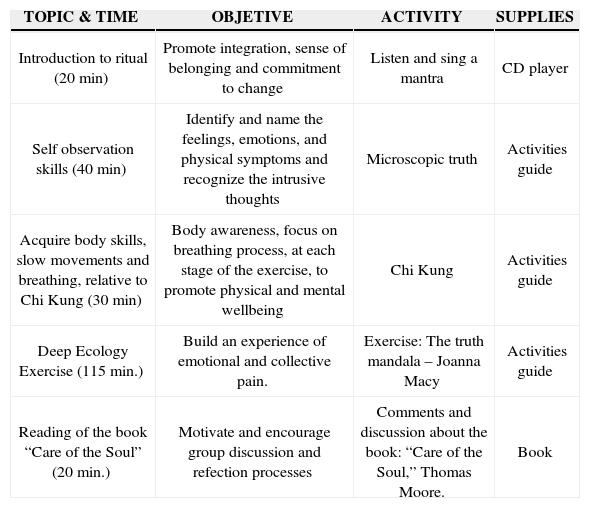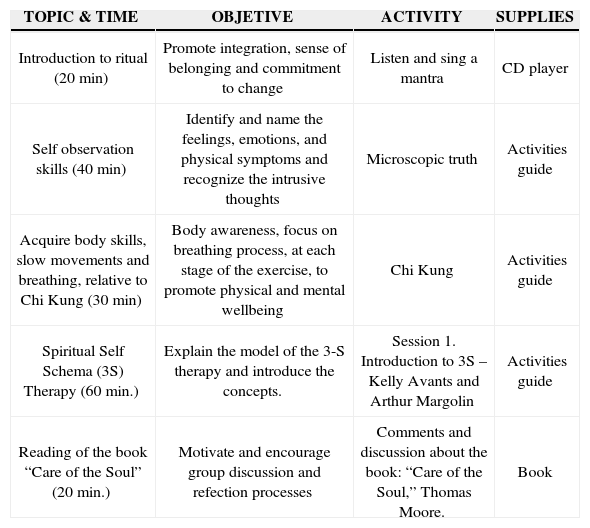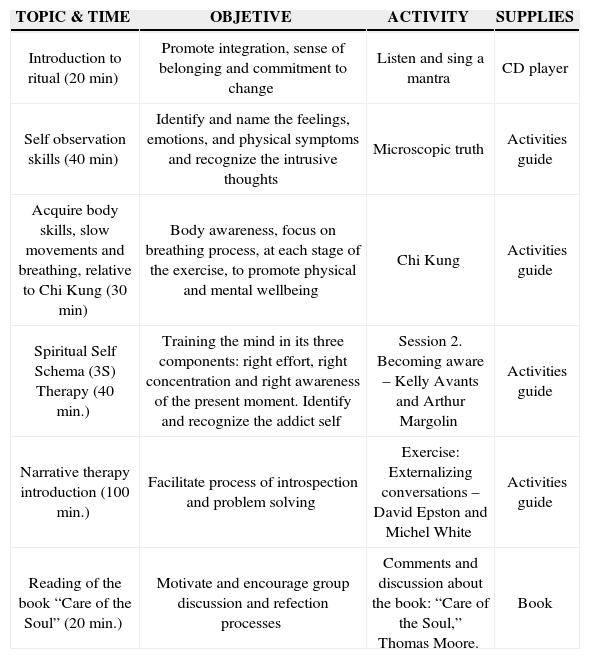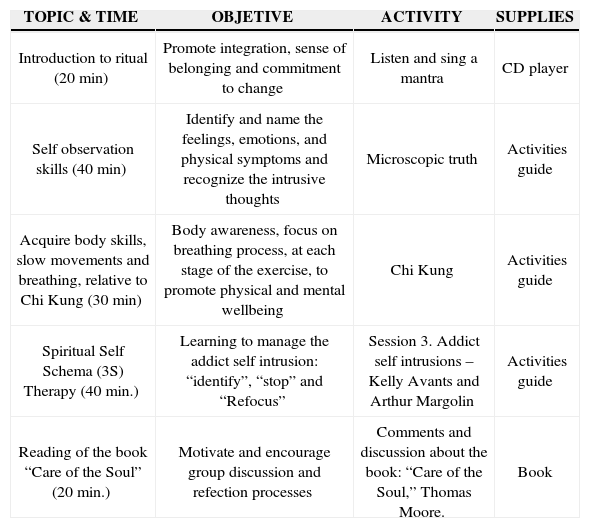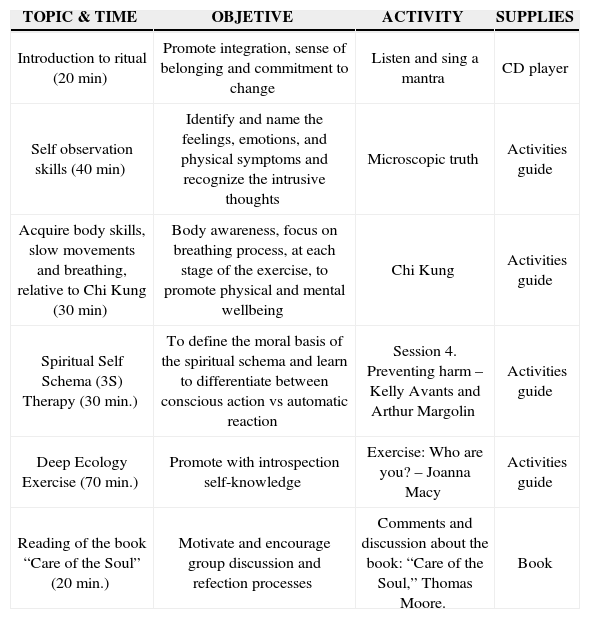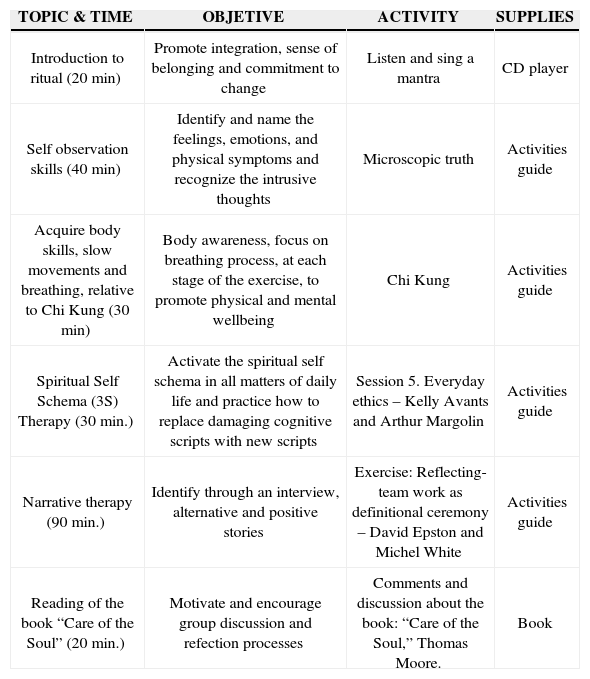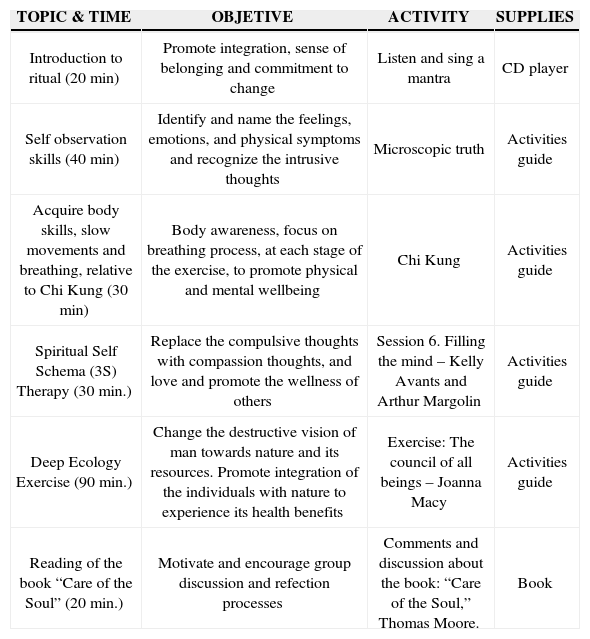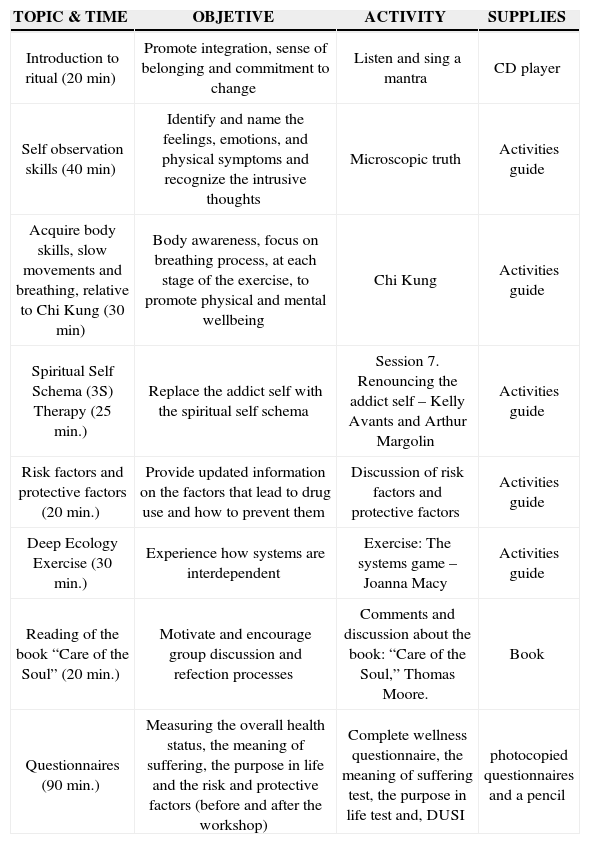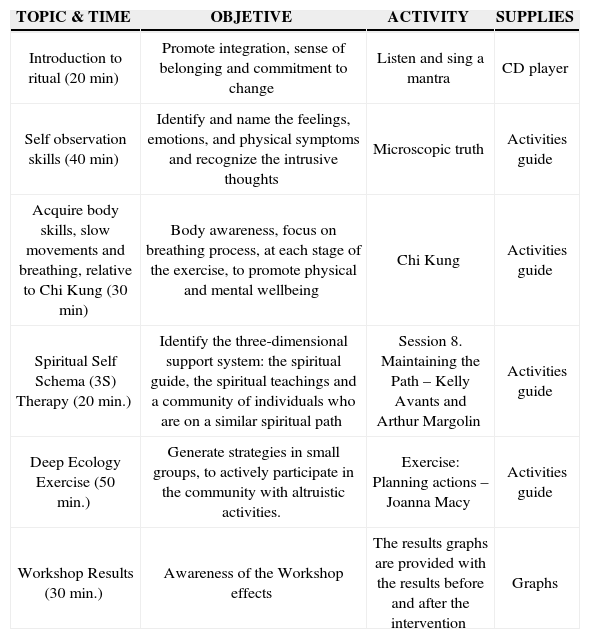In usual educational practice, it is common to observe a separation between the “academic” curriculum of the students from that of their personal and social development. Nonetheless, an increasing recognition of the value of the students’ personal and social development in the classroom, called “Positive Education”, is now in progress. Based on such efforts we elaborated a Psycho-Educative Intervention (PEI), with the purpose of integrating professional learning with Happiness and Wellbeing (H&W) through the teaching of healthy lifestyles in students of Universidad Veracruzana (UV). The positive effects of PEI upon the students’ H&W were found to be significant. Herein we report the effects of PEI on the students’ “academic” curricula, and on their duration over time, as well as try to explain their effects under the light of Positive Education. The effects of PEI on H&W were higher after PEI, but decreased four months later, although the scores were higher than those before PEI. Also, PEI improved the students’ school performance. One way to explain these effects of PEI is through the perspective of the three points (pleasant life, engaged life and meaningful life) raised by Positive Psychology, which were worked within the 15 Sessions of PEI to promote positive emotions and traits in the students.
En la práctica educativa habitual, es común observar una separación entre la currícula “académica” de los estudiantes y su desarrollo personal y social. Sin embargo, en la actualidad hay un creciente reconocimiento de la importancia que tiene el desarrollo personal y social de los alumnos para su desempeño en el aula, al cual se le ha denominado “Educación Positiva”. Basados en dichas propuestas elaboramos una Intervención Psicoeducativa (IPE), con el propósito de integrar el aprendizaje profesional con la felicidad y el bienestar (F y B), a través de la enseñanza de estilos de vida saludables en los estudiantes de la Universidad Veracruzana (UV). Se encontró que los efectos positivos de la IPE sobre la F y B de los estudiantes fueron estadísticamente significativos. En este artículo presentamos los efectos de la IPE en el desempeño “académico” de los estudiantes, la duración de sus efectos, así como la explicación de sus efectos a la luz de la Educación Positiva. Los efectos de la IPE sobre la F y B fueron mayores después de la IPE, pero disminuyeron a los cuatro meses de su aplicación, aunque conservando mayores puntajes a los medidos antes de la IPE. Además, la IPE aumentó el rendimiento escolar de los estudiantes. Una forma de explicar estos efectos del IPE es a través de la perspectiva de los tres puntos (vida placentera, vida comprometida y vida significativa) que plantea la Psicología Positiva, mismos que se desarrollaron con las 15 sesiones de la IPE para promover emociones y actitudes positivas en los estudiantes.
Although Happiness and Wellbeing (H&W) have been generally pursued by humans, we know not of a general agreement reached on how to achieve them (Arguís-Rey, Bolsas-Valero, Her-nández-Paniello & Slavador-Monge, 2010). Nor do we know if it’s recognized that there is no general way to do so, but that rather, on account of human diversity and variable circumstances, there might be a collection of different unique ways to do so.
Most individuals of Western Culture believe that H&W will come in a distant future, and in the form of material possessions or of favorable external circumstances, overlooking the possibility of immediate satisfaction (Arguís-Rey et al., 2010).
Educators often do the same mistakes possibly because they regard their students’ learning as an endowment of knowledge, skills and attitudes, that will pay-off someday, and help them find a good job and make their the living conditions happy (Arguís-Rey et al., 2010). They further believe that H&W derive automatically from having a formal education, a job and a family.
But, are students taught to be well and happy? If H&W are highly desired goals of human beings, why not cultivate them in the classroom?
In usual educational practice is common to observe a separation between the “academic” curriculum of the students, linked to their mastery of the disciplines’ specific information content, from their personal and social development aspects, linked to what it is called “the tutorial” curriculum (to learn to think, to be a person and to coexist with others) (Arguís-Rey et al., 2010). However, H&W are synergistic with better learning of information, for example: the positive psychological mood broadens attention (Bolte, Goschke, & Kuhl, 2003; Fredrickson, 1998; Fredrickson & Branigan, 2005; Rowe, Hirsh, Anderson, & Smith, 2007), and stimulates creative thinking (Estrada, Isen & Young, 1994; Isen, Daubman & Nowicki, 1987; Isen, Rosenzweig & Young, 1991; Kuhl, 1983, 2000), in contrast to negative psychological mood, which narrows attention (Bolte et al., 2003) and stimulates critical thinking and analytical thinking (Kuhl, 1983, 2000). Both ways of thinking are, of course, important but schools emphasize critical rather than creative thinking, and the negative mood, so often found in the classroom, facilitates mainly critical thinking (Seligman & Csikszentmihalyi, 2000).
In recent years, there has been an increasing recognition of the value of Positive Education and of its connection with the “academic” curriculum. For example, American schools are a major provider of mental health services (American Academy of Pediatrics, 2004; Foster et al., 2005). Schools also have enormous potential for illness prevention and promotion of H&W initiatives (American Academy of Pediatrics, 2004; Pfeiffer & Reddy, 1998; Weist, 2005). In the USA, most states now mandate or encourage character education, and many have standards related to social and emotional learning (Cohen, 2006; Collaborative for Academic, Social and Emotional Learning [CASEL], 2009). Britain’s education policy also includes the promotion of moral or character development in their students (Arthur, 2005).
The Universidad Veracruzana (UV) complies with the foregoing when it implements the principles of Integral Education (as professionals and as persons) in its students and promotes their learning towards a healthy lifestyle that will further strength their personal and social development.
Having the above in mind, we elaborated the Psycho-Educative Intervention (PEI) “Self-knowledge and Care of the Soul” with the purpose of integrate the professional learning and to promote healthy lifestyles in the students of UV, by the acquisition of the “Skills for Life”: self-knowledge, empathy, assertiveness, conviviality, decision making, solving of problems and conflicts, creativeness, criticism and management of emotions, feelings and stress (Banderas-Rodríguez, Martínez, & Romo-González, 2010; Montoya-Castilla & Muñoz-Iranzo, 2009; Moral & Ovejero, 2005).
The effects obtained by applying PEI to the students were measured numerically and statistically evaluated in an Experimental Group (intervened) and in a Control Group (not intervened), to corroborate that, indeed, PEI significantly improved the students’ behaviors and led them to higher levels in their H&W (Romo-Gonzalez et al., 2013a). The analysis indicated that the level of improvement in each questionnaire was of considerable magnitude and statistically significant, but also that there was a hierarchy or order of importance for each variable in the Health and Wellbeing Questionnaire, an order led by the Physical Variables, followed by the Mental and Emotional ones, and finally by those relating to Being and Meaning of Existence.
Although PEI improved attitudes in both women and men, it was found that women had better general scores in the five questionnaires before PEI than men but, after PEI, men improved their scores significantly, reaching levels similar to those of women and ranked the importance of the Response Variables quite similarly (Romo-Gonzalez et al., 2013a).
Also, we explored, as a way to test the multidimensional notion of Health and Behavior (Bradshaw, 2000; Becoña, 2002; De Leon, 2004; Nakken, 1998; Velasco, 2006), if the variables tested in the five questionnaires were independent or dependent variables Before and After PEI, that is, if there were positive and/or negative correlations (Pearson’s correlation coefficient) among them, in hope of revealing the existence of a Psycho-Emotional Network ruling the Psycho-Emotional status of an individual (Romo-Gonzalez et al., 2013b).
We found that the intensity values of the Psycho-Emotional variables of the students measured by the five questionnaires, organized the variables in the form of a network and, depending on the measurement employed, the importance in the ranks of the variables varied: with Thinking (S7), Communicating (S9), Purpose in Life (PIL) Intimacy (S10) and Risk (R), as the most outstanding hubs Before and After PEI, in both Women and Men, while Breathing (S2), Transcending (S12), Finding Meaning (S11), Playing/Working (S8) and Self-Responsibility and Love (S1), as secondary hubs connecting with the rest of the variables. We thought that the network organization of the Psycho-Emotional variables provides with a searching strategy in seeking for the shortest distance from a protective variable to a risky variable in order to correct it (Romo-González et al., 2013b).
In this article we intend to show the PEI effects upon the “academic” curriculum, estimating their persistence over time and try to explain its effects through the review of each of the techniques used, in the light of Positive Education and the Twenty and Four Character Strengths (Creativity, Curiosity, Open-mindedness, Love of learning, Perspective, Bravery, Persistence, Integrity, Vitality, Love, Kindness, Social intelligence, Citizenship, Fairness, Leadership, Forgiveness, Humility, Prudence, Self-regulation, Appreciation of beauty, Gratitude, Hope, Humor, Spirituality) (Seligman & Csikszentmihalyi, 2000).
MethodologyExperimental Design and Selection of ParticipantsThe present study had a pre-post test design, PEI in our case. The participants were recruited from students registered in a professional career at Universidad Veracruzana, of either sex, and of 19-30 years of age, which volunteered to participate in PEI, and had completed the PEI or complied with an attendance of 80%. Sample size was limited to a maximum of 30 students, because the effectiveness of group interventions decreases with increasing the number of participants above thirty (Ayala-Velazquez, 1998). Random sampling of participants was not performed because the inscription of the students to PEI was “online”, open to all the students in the UV, Veracruz region and by law, its access to PEI may not be refused by the institution once the student is accepted by UV.
It is important to note that all of the UV students who participated in this study had similar idiosyncrasies (culture, social level, income) and that none of the students had a disenfranchised profile since Public Education in Mexico is, by law, offered gratuitously to all Mexican citizens.
In this way, 30 participants were registered in the Group, 27 finished the PEI, 20 of which were women and 7 were men. The average age was 21 years, and 20 were studying Nursing.
No ethical committee was necessary to consult and approve this project since all of the students were invited to take part in the study after the research assistants had read and explained to them a short description of the study and of its possible effects, and then asked the students to sign a form of Informed Consent if they volunteered to participate.
Instruments of Measurement: QuestionnairesAll questions of all the Questionnaires were translated by the Back-translation method and validated.
- 1)
The Health and Wellbeing Questionnaire (Wellness Inventory) by Travis and Ryan (1999), consists of 296 questions divided into 12 Sections. The Sections are: Self-Responsibility and Love (S1), Breathing (S2), Sensing (S3), Eating (S4), Moving (S5), Feeling (S6), Thinking (S7), Playing and Working (S8), Communicating (S9), Intimacy (S10), Finding Meaning (S11) and Transcending (S12). The questions are graded from 1 to 4 and the values are added, and then divided by the number of questions to obtain the average score of the questionnaire of each individual. The psychometric properties of this questionnaire were evaluated by Palombi (1992), the internal consistency proved to be very high (0.93), in accordance with Cronbach’s calculation of the alpha correlation coefficient.
- 2)
The Purpose-In-Life (PIL) Questionnaire by Crumbaugh and Moholick (1981) evaluates the individuals’ attitude towards life, particularly the magnitude of the “existential vacuum” (Frankl, 1990). The PIL contains 20 questions, which are graded from 1 to 7; then the values are added and divided by the number of questions to obtain an average of PIL for each individual. The reliability of this instrument was analyzed with the method of the “two halves” of Crumbaugh and Mo-holick (1981), thereby obtaining Pearsons’ correlation coefficient (r = .81, n=225, P<0.05). To interpret the scores in the PIL, it should be noted that score intervals from 92 to 112 represent an undefined situation regarding Goals and Purpose In Life; whereas scores grater of 113 suggest their presence, while scores lower than 91, indicate their absence or an “existential vacuum”.
- 3)
The Meaning In Suffering Test (Questionnaire) (MIST) by Starck (1985) measures the capacity of individuals to find Meaning In Suffering resulting from those unavoidable painful experiences that will have to be faced at some stage of their lives. It is a self-applied questionnaire, divided into parts: Part I contains 20 questions consisting of affirmations about pain; it uses a grading range from 1 to 7, in which 1 indicates that the individual has “never” felt or does not believe in the affirmations presented; number 2 indicates they “rarely” do, and so-on until reaching number 7, which indicates he “constantly” feels it or does believe in the affirmation; Part II contains 17 additional questions to which the individual must also respond, although in this study only the questions in part I were used. The reliability of this instrument is high (r = .81). Once the answers to the questionnaire have been completed, the sum of all the scores of all reagents is divided by the total number of questions in part I (20) to obtain an average.
- 4)
The Drug Use Screening Inventory (DUSI) Questionnaire (Risk and Protection Factors) by Tarter and Hegedus (1991), modified by Diáz-Negrete, González-Sánchez & García-Aurrecoechea (2006), contains 135 questions characterized as having binomial answers: “yes” (1) or “no” (0). The Protection scores are the sum of the “no” answers and the Risk scores are the sum of the “yes” answers. The greater the Protective Factors are, the risk of becoming involved in drug consumption diminishes. The reliability of this instrument was evaluated by using the Cronbach alpha correlation coefficient, which gave a high result (α=0.97) and an explained 83% of the total variance. This questionnaire measures the severity of the consumption tendency in domains: 1) Substance abuse, 2) Psychiatric disorder, 3) Behavioral problems, (4) Health status, 5) School adjustment, 6) Family adjustment (SF), 7) Work adjustment, 8) Peer relations, 9) Social competency, 10) leisure/ recreation. This questionnaire has been used with adults and adolescents to measure the extent of the change occurring in the tendency to consume drugs once an educative intervention or treatment has been applied in those individuals that needed to increment preventive aspects in their personal behaviors. It is, therefore, a highly useful questionnaire, both for measuring preventive aspects in the youngsters and for indicating the need of intervention or treatment of persons who are addicted or in great risk of becoming addicted.
- 5)
The Perception of Stress Questionnaire (PSQ) by Levenstein et al. (1993) is self-administered and consists of 30 questions that are graded on a Likert-type scale of 4 degrees. The questionnaire is applied twice: the first (Past) in reference to the patient’s situation during the last year or two years, and the other (Recent) in reference to the patient’s situation during the last month. In both cases an index is obtained from the average of all the questions, which can oscillate from 0 (very low level of stress perceived) to 1 (very high level of stress perceived). This questionnaire has proved to have concurrent validity and high internal consistency. The reliability level is 0.80, with a cutoff value of 45; the sensitivity (true positives) is 86% and the specificity (true negatives) is 78%.
The five questionnaires were applied to Cases during the first day of classes. In the Cases Group, the PEI “Self-knowledge and Care of the Soul” was taught in the intersemestral period of winter, 2011, every day of the week, from Monday to Friday, between 10 a.m. to 2 p.m., in a garden of the Mocambo campus installations, Veracruz Region, of UV. The PEI is really a form of treatment of the students possible negative attitudes and behaviors which difficult attaining health and wellbeing.
The PEI consists of a total of 15 sessions, given one per day from Monday to Friday, for three weeks. PEI includes different methodologies which offer the participants an opportunity to engage in their personal introspection and knowledge (Romo-González & Banderas-Rodríguez, 2011). For that purpose we adopted a comprehensive and multidimensional perspective of the individual, which differs from traditional workshops at other institutions. Our includes strengthening the individuals’ H&W protective factors through the individuals reconnection with their bodies, emotions, thoughts, communities and environments. Thus improving the individuals’ understanding the meaning of their lives and the worthiness of positive values, behaviors and beliefs, as well as inducing a sense of respect for themselves, the others and for their environments.
These methodologies consisted of exercises of Deep Ecology (i.e., “The Work that Reconnects”, “Despair Work”, “The Shift: Seeing with New Eyes”) (Macy & Brown, 1998), breathing and meditation techniques, body exercises of “Chi-Kung” (Chia & Li, 2001) and some bioenergetic exercises (i.e., “Cellular Breathing”, “Umbilical Centre in the Navel Radiation Pattern”) (Hartley, 1995; Lowen, 1975), narrative therapy (i.e., “Externalizing Conversations”, “Defnitional Ceremony and Outsider-Witness”) (White & Epston, 1993) and exercises of visualization and meditation, with elements of the Spiritual Self Schema Therapy (3S) (Avants & Margolin, 2004) (For more details on the nature, sequence and duration of PEI’s activities see Supplementary Material).
PEI registers as Response Variables: Health and Wellbeing, Purpose In Life, Meaning in Self Suffering and That of Others, Risk and Protection factors of Drug abuse which are numerically scored in individual participants Before and After the PEI.
The day before the end of the PEI (on the fourteenth session), the five questionnaires were applied again (four months later) to the same participants to measure the effects of PEI upon them.
Data AnalysisTo estimate the effects of the PEI, a comparison was made between the scores obtained on the five questionnaires before and after and four months later the PEI sessions.
The statistical significance of the grades comparison Before and After the PEI sessions was done by repeated measures ANOVA, independent data and the evaluation of its persistence over time was done of individual scores (Zar, 1999). Also, before applying the statistical tests, we verified that the response variables fulfilled the assumption of normality and homogeneity of variances. A Principal Components analysis was conducted for the six variables before PEI, after PEI, and four months later, and the factor score of the components associated with linear regression models. All analyses were performed in Statistica 7.0 StatSof, Inc. 1984-2004.
Detailed results and discussionsAcademic performance after PEITo evaluate the effects of PEI on student learning, we requested the students’ grades during the period of 2011 (Before PEI) and of 2012 (After the PEI). The results show that the academic performance of students improved significantly at the end of PEI (F= 7.2, P = 0.01, 103%, Before PEI 8.09 ± 0.13 EE vs. After the PEI 8.5 ± 0.18 EE), even when PEI was not oriented towards improving their academic curriculum profile. This is consistent with the Positive Education postulates, in which H&W is linked to better learning (Bolte et al., 2003; Estrada et al., 1994; Fredrickson, 1998; Fredrickson and Branigan, 2005; Isen et al., 1987; Isen et al., 1991; Kuhl, 1983, 2000; Rowe et al., 2007; Seligman & Csikszentmihalyi, 2000).
Effects of PEI over timeTo evaluate the persistence over time of the effects of PEI upon the students’ scores in the Psycho-emotional Variables (five questionnaires) before PEI, one day after PEI, and four months afterwards, scores in each time were compared. Results showed that PEI positive global scores in most of the questionnaires were sustained for one day (H&W Fig. 1A; MIST Fig. 1B; PIL Fig. 1C; Risk Fig. 1D; Protection Fig. 1E and PSQ Fig. 1F) and then decreased four months later in H&W, MIST, PIL and PSQ), although to levels above those of before PEI (H&W P= 0.02; PIL P= 0.08; PSQ P= 0.008). However, it is noteworthy that, in the case of the Risk and Protection Variables, the effects of PEI were not only sustained, but decreased and increased, respectively (Fig. 1D and E). So it seems that the effect of PEI strengthens the students’ resistance of the impulse to consume drugs under stressful or critical situations, or just for the sake of pleasure.
In contrast, the effect of PEI on the Meaning in Suffering was not maintained through time since its score measured four months After PEI, was even lower than its score Before PEI (Fig. 1D). The short living effect of PEI in this issue could refect that only two sessions of PEI were dedicated to this variable, or it might be the result of the students having lost their ability to understand Suffering after they had felt the benefice of having improved in their H&W by way of PEI. It should also be noticed that there were considerable and significant variations among the individual students, some increasing and others decreasing with time after PEI.
Besides the biological and cultural diversity among the participants as the cause behind the variation in their academic grades and PEI scores, a plausible explanation to the dynamics of improvement after PEI (first increasing and later diminishing somewhat), may result from the plural and contradictory society in matters of moral and civic values, currently existing in Mexico, which could minimize the effects of PEI and limit their duration.
The long-term enjoyment of the benefits from PEI would seem to require repetition, refection, training, perseverance and optimization at the personal state of each individual, in time, space and circumstance. So, it would be necessary to create academic spaces within the university, where the students may extend their practice of the skills developed by PEI.
It was also performed a Multivariate analysis to prove the PEI effects over time. The principal component analysis for the six response variables showed linear association with a high value of percentage of variance explained by the first two components in the registry before and only the variable MIST and Perception of Stress were least contributed their score (Table 1A). The phase response after linear association showed a high variable too high percentage of variance explained and the variable PSQ was the least contribute (Table 1B). After four months, the response of individuals also showed linear association with high value of percentage of variance explained, but again the variables MIST and Perception of Stress were the least contribution had on the linear association (Table 1C).
Saturation factor for the contribution of the variables: Health and Wellbeing (H & W), Meaning in Suffering (MIST), Purpose in Life (PIL), Risk Factors, Protection Factors and Perception of Stress (PSQ) for principal components (PC1 and PC2). In addition to the score and percentage of explained variance Before multi-variate analysis (A) After (B) and Four months later (C).
| (A) Before | (B) After | (C) Four months later | ||||
|---|---|---|---|---|---|---|
| PC 1 | PC 2 | PC 1 | PC 2 | PC 1 | PC 2 | |
| H & W | −0.80 | −0.46 | −0.71 | −0.55 | −0.82 | 0.45 |
| MIST | −0.69 | −0.27 | −0.65 | −0.62 | −0.51 | 0.45 |
| PIL | −0.72 | −0.52 | −0.85 | 0.07 | −0.82 | 0.28 |
| Risk Factors | 0.86 | −0.33 | 0.94 | −0.26 | 0.79 | 0.60 |
| Protection Factors | −0.89 | 0.37 | −0.94 | 0.26 | −0.80 | −0.58 |
| PSQ | 0.64 | −0.50 | 0.83 | −0.30 | 0.69 | −0.17 |
| Eigenvalue | 3.57 | 1.05 | 4.10 | 0.93 | 3.35 | 1.21 |
| Proportion total (%) | 0.59 | 0.17 | 0.68 | 0.16 | 0.56 | 0.20 |
The generalization of the success of PEI to all students of UV require of further studies in a bigger sample.
In the principal components analysis was obtained that the second components did not have any contribution, since there were no linear association scores. So the factor score of the first components were analyzed with linear regressions and obtained scores association of individuals between the phase before vs. after (y = 7.6 e-6 0.68 * x, F = 22, P <0.0001, r2 = 0.45) and between before vs. four months later (y = 1.4 e-5 0.65 * x, F = 22, P <0.0001, r2 = 0.40) (Fig. 2). This shows that the intervention on study subjects remains immediately After PEI and Four months later.
Effects of PEI under the light of Positive EducationAccording to Seligman (2002), the three basic pillars of Positive Psychology are: positive emotions, positive traits (virtues and personal strengths) and positive institutions which facilitate the development of these emotions and traits. So, from this perspective, H&W depend less on the external World than on how we perceive it. That is, we need to develop personal skills and strengths that will help us enjoy, balance and find purpose in our lives. H&W also includes achieving: the ‘Pleasant Life’, in which life is a an experience of positive emotions, focusing primarily on sensory and emotional pleasures, which are ephemeral and dependent on external circumstances; the ‘Engaged Life’, which is a result of using personal strengths to obtain benefits in major areas of life; and the ‘Meaningful Life’, which is to use the personal strengths, virtues and features at the service of some purpose that transcends our individual concerns (Linley, Joseph, Harrington & Wood, 2006; Seligman, 2002).
From the perspective of Positive Psychology, the contents of PEI meet with its Three Basic Pillars. The first phase (Sessions 1-5), is centered on the pleasures obtained through the recon-nection of the individual with itself (its senses) and with Nature. To achieve this purpose, techniques such as Chi-Kung and relaxation were used, which invigorate vital energy and enhance our perception of the world, and Deep Ecology Techniques which connect us with the natural world (Chia & Li, 2001; Hartley, 1995; Macy & Brown, 1998).
In the second phase (Sessions 6-7), the physical and emotional pains were explored in order to change the students perception of them. That is, towards the reconnection of pain we begin the search of the Meaning in Suffering from the point of view of Eco-Psychology and Bioenerge-tics (Lowen, 1975; Macy & Brown, 1998), in which pain and suffering are ways to learn and not only a burden of life. We pursued this goal because the greater good is obtained if, instead of only pursuit pleasure, the students strive to involve himself with the Engaged Life and Meaningful Life (Peterson, Park & Seligman, 2005; Seligman, Steen, Park & Peterson, 2005).
Finally, to enhance the effects of Engaged Life and of Meaningful Life, during the third phase (session 8-15), the student is endowed with a more positive and committed self through narrative therapy (White & Epston, 1993) and through the practice of the Twenty and Four Strengths by way of the Spiritual Self Schema therapy (Avants & Margolin, 2004). This includes the identification and renunciation of a Damaging Schema and its replacement it by the Spiritual Schema practicing Anapanasati Meditation, exercising the Ten Spiritual Muscles (Paramis) (strong determination, effort, equanimity, morality, loving kindness, tolerance, generosity, renunciation, wisdom and truth) and by commitment to preserve and promote life in Earth (Macy & Brown, 1998). All this allows the person to flow and have positive emotions but also to achieve Meaningful Life by strengthening connections with others and with those of future generations and for causes that transcend the self and now (Durkheim, 1951; Erikson, 1963).
As mentioned before, we started with the idea that H&W are inner and innate attitudes of the human being which, however, they can be educated through a process of change involving the improvement of ways of thinking, feeling and acting, and thus achieve a more fulfilling life, in spite of our biological limitations and of uncontrolled circumstantial change (Arguís-Rey et al., 2010).
DiscusionsThe effects generated by PEI in psycho-emotional variables improved most of the students’ school performance (increase in average grades), perhaps because PEI increased more their creative thinking than their critical thinking.
The positive effect of PEI upon the students’ scores showed individual variations but they were generally higher than Before PEI immediately After PEI, and tended to decrease four months later to levels that were, however, higher than Before PEI.
It is noteworthy that the reduction of the effect of PEI over time is not that clear when the variables were analyzed together.
In order to maintain the positive effects of PEI, it would seem necessary that the students continue practicing and perfecting the skills learned from PEI.
The variables associated with Risk and Protection towards Drug Consumption deviate from the general dynamics of the effects of PEI, since they decrease or increase four months After PEI, respectively, thus improving the students’ H&W.
Another variable that stands-out of the rest because of its scores differences in times After PEI is the Meaning in Suffering, in which the students’ scores four months After PEI were even lower than those Before PEI, possibly because the students improved H&W makes of Suffering more a calamity than a boon.
One way to explain the effects of PEI is through the perspective of the three points raised by Positive Psychology (‘Pleasant Life’, ‘Engaged Life’ and ‘Meaningful Life’), which were worked within the 15 Sessions of PEI to promote positive emotions and traits in the students.
The extension of PEI to other undergraduate careers in the UV may strengthen the institution promotion of positive emotions and traits in its students, thus fulfilling the Three Pillars of Positive Education (Seligman, Ernst, Gillham, Reivich & Linkins, 2009).
Objective: Explain the workshop dynamic, framing and evaluation form. Perform a group integration activity and apply the questionnaires.
| TOPIC & TIME | OBJETIVE | ACTIVITY | SUPPLIES |
|---|---|---|---|
| Students and facilitators presentation (20 min) | Build group trust | The game of names. Facilitator says his name and then he throws a ball, the student who catches the ball says his name and that of the person who threw him the ball. The game finished when the last student says his name and the names of all the participants | Fabric ball |
| Self observation skills (40 min) | Identify and name feelings, emotions, and physical symptoms. Recognize intrusive thoughts | Microscopic truth. The group sat in a circle. Each of the participants pays attention and focus on how he feels physically, emotionally and mentally | Activities guide |
| Acquire body skills, slow movements and breathing, relative to Chi Kung (20 min) | Body awareness, focus on breathing process, at each stage of the exercise, to promote physical and mental wellbeing | The group standing in a circle. Chi Kung is to balance the three basic attributes of human life: the body, the breathing and the mind. Through the rhythmic coordination of body and breathing, balance and posture, inhalation and exhalation. In order to find the perfect balance between movement and stillness | Activities guide |
| Questionnaires (90 min) | Measuring overall health status, meaning of suffering, purpose in life and the risk and protective factors | Complete wellness questionnaire, the meaning of suffering test, the purpose in life test and, DUSI inventory | Photocopied questionnaire and a pencil |
Objective: Promote awareness on drug consumption prevention and the importance of health care
| TOPIC & TIME | OBJETIVE | ACTIVITY | SUPPLIES |
|---|---|---|---|
| Introduction to ritual (20 min) | Promote integration, sense of belonging and commitment to change | Listen and sing a mantra | CD player |
| Self observation skills (40 min) | Identify and name the feelings, emotions, and physical symptoms and recognize the intrusive thoughts | Microscopic truth | Activities guide |
| Acquire body skills, slow movements and breathing, relative to Chi Kung (30 min) | Body awareness, focus on breathing process, at each stage of the exercise, to promote physical and mental wellbeing | Chi Kung | Activities guide |
| Information about alcohol and other drugs and their effects on health (60 min) | Provide information on addictions, and their health damage | Listen the tape: Addictions, Dr. Deepak Chopra. | Deepak Chopra tape, tape recorder |
Objective: To promote through body exercises, the individual’s health care.
| TOPIC & TIME | OBJETIVE | ACTIVITY | SUPPLIES |
|---|---|---|---|
| Introduction to ritual (20 min) | Promote integration, sense of belonging and commitment to change | Listen and sing a mantra | CD player |
| Self observation skills (40 min) | Identify and name the feelings, emotions, and physical symptoms and recognize the intrusive thoughts | Microscopic truth | Activities guide |
| Acquire body skills, slow movements and breathing, relative to Chi Kung (30 min) | Body awareness, focus on breathing process, at each stage of the exercise, to promote physical and mental wellbeing | Chi Kung | Activities guide |
| Deep Ecology Exercise (60 min.) | Foster and recreate the connection with the body, breathing and with nature | Exercise: The Warm-ups: Opening to Breath, Body, Sound and Silence – Joanna Macy | Activities guide |
Objective: To promote in the individuals with body exercises the experience of physical, emotional and mental wellness.
| TOPIC & TIME | OBJETIVE | ACTIVITY | SUPPLIES |
|---|---|---|---|
| Introduction to ritual (20 min) | Promote integration, sense of belonging and commitment to change | Listen and sing a mantra | CD player |
| Self observation skills (40 min) | Identify and name the feelings, emotions, and physical symptoms and recognize the intrusive thoughts | Microscopic truth | Activities guide |
| Acquire body skills, slow movements and breathing, relative to Chi Kung (30 min) | Body awareness, focus on breathing process, at each stage of the exercise, to promote physical and mental wellbeing | Chi Kung | Activities guide |
| Deep Ecology Exercise (80 min.) | Generate a sensory experience, through the perception of the environment without seeing (touch, taste, smell and hearing) | Exercise: The Mirror Walk – Joanna Macy | Activities guide |
| Deep Ecology Exercise (80 min.) Reading of the book “Care of the Soul” (20 min.) | Motivate and encourage group discussion and refection processes | Comments and discussion about the book: “Care of the Soul,” Thomas Moore. | Book |
Objective: To promote with physical exercises, the individual’s introspection.
| TOPIC & TIME | OBJETIVE | ACTIVITY | SUPPLIES |
|---|---|---|---|
| Introduction to ritual (20 min) | Promote integration, sense of belonging and commitment to change | Listen and sing a mantra | CD player |
| Self observation skills (40 min) | Identify and name the feelings, emotions, and physical symptoms and recognize the intrusive thoughts | Microscopic truth | Activities guide |
| Acquire body skills, slow movements and breathing, relative to Chi Kung (30 min) | Body awareness, focus on breathing process, at each stage of the exercise, to promote physical and mental wellbeing | Chi Kung | Activities guide |
| Hike (35min.) | Focus attention and concentration on perception through the senses | Performing a silent walk in nature. | None |
| Body mind centering exercise (80 min.) | To promote a state of deep relaxation, in order to explore the cellular breathing | Exercises: Cellular Breathing and Navel radiation pattern – Linda Hartley | Activities guide |
| Reading of the book “Care of the Soul” (20 min.) | Motivate and encourage group discussion and refection processes | Comments and discussion about the book: “Care of the Soul,” Thomas Moore. | Book |
Objective: To promote the individual’s connection with pain, to change their attitude to the meaning of suffering.
| TOPIC & TIME | OBJETIVE | ACTIVITY | SUPPLIES |
|---|---|---|---|
| Introduction to ritual (20 min) | Promote integration, sense of belonging and commitment to change | Listen and sing a mantra | CD player |
| Self observation skills (40 min) | Identify and name the feelings, emotions, and physical symptoms and recognize the intrusive thoughts | Microscopic truth | Activities guide |
| Acquire body skills, slow movements and breathing, relative to Chi Kung (30 min) | Body awareness, focus on breathing process, at each stage of the exercise, to promote physical and mental wellbeing | Chi Kung | Activities guide |
| Planting a seed (25 min.) | Foster care towards living beings and sense of responsibility towards nature | Planting a vegetable seed and take it home for their care | Cups, seeds and potting soil |
| Deep Ecology Exercise (90 min.) | Fostering empathy for another’s pain | Exercise: The milling – Joanna Macy | Activities guide |
| Reading of the book “Care of the Soul” (20 min.) | Motivate and encourage group discussion and refection processes | Comments and discussion about the book: “Care of the Soul,” Thomas Moore. | Book |
Objective: To promote the individuals connection with pain, and a change of attitude to the meaning of suffering.
| TOPIC & TIME | OBJETIVE | ACTIVITY | SUPPLIES |
|---|---|---|---|
| Introduction to ritual (20 min) | Promote integration, sense of belonging and commitment to change | Listen and sing a mantra | CD player |
| Self observation skills (40 min) | Identify and name the feelings, emotions, and physical symptoms and recognize the intrusive thoughts | Microscopic truth | Activities guide |
| Acquire body skills, slow movements and breathing, relative to Chi Kung (30 min) | Body awareness, focus on breathing process, at each stage of the exercise, to promote physical and mental wellbeing | Chi Kung | Activities guide |
| Deep Ecology Exercise (115 min.) | Build an experience of emotional and collective pain. | Exercise: The truth mandala – Joanna Macy | Activities guide |
| Reading of the book “Care of the Soul” (20 min.) | Motivate and encourage group discussion and refection processes | Comments and discussion about the book: “Care of the Soul,” Thomas Moore. | Book |
Objective: To provide in the participant, the elements for emotions managing and cognitive processes which generate intrusive thoughts.
| TOPIC & TIME | OBJETIVE | ACTIVITY | SUPPLIES |
|---|---|---|---|
| Introduction to ritual (20 min) | Promote integration, sense of belonging and commitment to change | Listen and sing a mantra | CD player |
| Self observation skills (40 min) | Identify and name the feelings, emotions, and physical symptoms and recognize the intrusive thoughts | Microscopic truth | Activities guide |
| Acquire body skills, slow movements and breathing, relative to Chi Kung (30 min) | Body awareness, focus on breathing process, at each stage of the exercise, to promote physical and mental wellbeing | Chi Kung | Activities guide |
| Spiritual Self Schema (3S) Therapy (60 min.) | Explain the model of the 3-S therapy and introduce the concepts. | Session 1. Introduction to 3S – Kelly Avants and Arthur Margolin | Activities guide |
| Reading of the book “Care of the Soul” (20 min.) | Motivate and encourage group discussion and refection processes | Comments and discussion about the book: “Care of the Soul,” Thomas Moore. | Book |
Objective: To provide tools to the participants for stress and crisis situations management.
| TOPIC & TIME | OBJETIVE | ACTIVITY | SUPPLIES |
|---|---|---|---|
| Introduction to ritual (20 min) | Promote integration, sense of belonging and commitment to change | Listen and sing a mantra | CD player |
| Self observation skills (40 min) | Identify and name the feelings, emotions, and physical symptoms and recognize the intrusive thoughts | Microscopic truth | Activities guide |
| Acquire body skills, slow movements and breathing, relative to Chi Kung (30 min) | Body awareness, focus on breathing process, at each stage of the exercise, to promote physical and mental wellbeing | Chi Kung | Activities guide |
| Spiritual Self Schema (3S) Therapy (40 min.) | Training the mind in its three components: right effort, right concentration and right awareness of the present moment. Identify and recognize the addict self | Session 2. Becoming aware – Kelly Avants and Arthur Margolin | Activities guide |
| Narrative therapy introduction (100 min.) | Facilitate process of introspection and problem solving | Exercise: Externalizing conversations – David Epston and Michel White | Activities guide |
| Reading of the book “Care of the Soul” (20 min.) | Motivate and encourage group discussion and refection processes | Comments and discussion about the book: “Care of the Soul,” Thomas Moore. | Book |
Objective: Identify and learn to stop intrusive thoughts, using tools that promote wellness.
| TOPIC & TIME | OBJETIVE | ACTIVITY | SUPPLIES |
|---|---|---|---|
| Introduction to ritual (20 min) | Promote integration, sense of belonging and commitment to change | Listen and sing a mantra | CD player |
| Self observation skills (40 min) | Identify and name the feelings, emotions, and physical symptoms and recognize the intrusive thoughts | Microscopic truth | Activities guide |
| Acquire body skills, slow movements and breathing, relative to Chi Kung (30 min) | Body awareness, focus on breathing process, at each stage of the exercise, to promote physical and mental wellbeing | Chi Kung | Activities guide |
| Spiritual Self Schema (3S) Therapy (40 min.) | Learning to manage the addict self intrusion: “identify”, “stop” and “Refocus” | Session 3. Addict self intrusions – Kelly Avants and Arthur Margolin | Activities guide |
| Reading of the book “Care of the Soul” (20 min.) | Motivate and encourage group discussion and refection processes | Comments and discussion about the book: “Care of the Soul,” Thomas Moore. | Book |
Objective: To provide and encourage the change and generate cognitive behavioral skills relating to healthy lifestyles.
| TOPIC & TIME | OBJETIVE | ACTIVITY | SUPPLIES |
|---|---|---|---|
| Introduction to ritual (20 min) | Promote integration, sense of belonging and commitment to change | Listen and sing a mantra | CD player |
| Self observation skills (40 min) | Identify and name the feelings, emotions, and physical symptoms and recognize the intrusive thoughts | Microscopic truth | Activities guide |
| Acquire body skills, slow movements and breathing, relative to Chi Kung (30 min) | Body awareness, focus on breathing process, at each stage of the exercise, to promote physical and mental wellbeing | Chi Kung | Activities guide |
| Spiritual Self Schema (3S) Therapy (30 min.) | To define the moral basis of the spiritual schema and learn to differentiate between conscious action vs automatic reaction | Session 4. Preventing harm – Kelly Avants and Arthur Margolin | Activities guide |
| Deep Ecology Exercise (70 min.) | Promote with introspection self-knowledge | Exercise: Who are you? – Joanna Macy | Activities guide |
| Reading of the book “Care of the Soul” (20 min.) | Motivate and encourage group discussion and refection processes | Comments and discussion about the book: “Care of the Soul,” Thomas Moore. | Book |
Objective: Rehearse behavioral skills to adopt a healthy lifestyle.
| TOPIC & TIME | OBJETIVE | ACTIVITY | SUPPLIES |
|---|---|---|---|
| Introduction to ritual (20 min) | Promote integration, sense of belonging and commitment to change | Listen and sing a mantra | CD player |
| Self observation skills (40 min) | Identify and name the feelings, emotions, and physical symptoms and recognize the intrusive thoughts | Microscopic truth | Activities guide |
| Acquire body skills, slow movements and breathing, relative to Chi Kung (30 min) | Body awareness, focus on breathing process, at each stage of the exercise, to promote physical and mental wellbeing | Chi Kung | Activities guide |
| Spiritual Self Schema (3S) Therapy (30 min.) | Activate the spiritual self schema in all matters of daily life and practice how to replace damaging cognitive scripts with new scripts | Session 5. Everyday ethics – Kelly Avants and Arthur Margolin | Activities guide |
| Narrative therapy (90 min.) | Identify through an interview, alternative and positive stories | Exercise: Reflecting-team work as definitional ceremony – David Epston and Michel White | Activities guide |
| Reading of the book “Care of the Soul” (20 min.) | Motivate and encourage group discussion and refection processes | Comments and discussion about the book: “Care of the Soul,” Thomas Moore. | Book |
Objective: To promote, through an experience that we are beings integrated to nature, a change of perception of the world and propitiate the care for our planet.
| TOPIC & TIME | OBJETIVE | ACTIVITY | SUPPLIES |
|---|---|---|---|
| Introduction to ritual (20 min) | Promote integration, sense of belonging and commitment to change | Listen and sing a mantra | CD player |
| Self observation skills (40 min) | Identify and name the feelings, emotions, and physical symptoms and recognize the intrusive thoughts | Microscopic truth | Activities guide |
| Acquire body skills, slow movements and breathing, relative to Chi Kung (30 min) | Body awareness, focus on breathing process, at each stage of the exercise, to promote physical and mental wellbeing | Chi Kung | Activities guide |
| Spiritual Self Schema (3S) Therapy (30 min.) | Replace the compulsive thoughts with compassion thoughts, and love and promote the wellness of others | Session 6. Filling the mind – Kelly Avants and Arthur Margolin | Activities guide |
| Deep Ecology Exercise (90 min.) | Change the destructive vision of man towards nature and its resources. Promote integration of the individuals with nature to experience its health benefits | Exercise: The council of all beings – Joanna Macy | Activities guide |
| Reading of the book “Care of the Soul” (20 min.) | Motivate and encourage group discussion and refection processes | Comments and discussion about the book: “Care of the Soul,” Thomas Moore. | Book |
Objective: To promote in the students the strengthening of the protective factors and the reduction risk factors to unsafe behaviors such as drug abuse.
| TOPIC & TIME | OBJETIVE | ACTIVITY | SUPPLIES |
|---|---|---|---|
| Introduction to ritual (20 min) | Promote integration, sense of belonging and commitment to change | Listen and sing a mantra | CD player |
| Self observation skills (40 min) | Identify and name the feelings, emotions, and physical symptoms and recognize the intrusive thoughts | Microscopic truth | Activities guide |
| Acquire body skills, slow movements and breathing, relative to Chi Kung (30 min) | Body awareness, focus on breathing process, at each stage of the exercise, to promote physical and mental wellbeing | Chi Kung | Activities guide |
| Spiritual Self Schema (3S) Therapy (25 min.) | Replace the addict self with the spiritual self schema | Session 7. Renouncing the addict self – Kelly Avants and Arthur Margolin | Activities guide |
| Risk factors and protective factors (20 min.) | Provide updated information on the factors that lead to drug use and how to prevent them | Discussion of risk factors and protective factors | Activities guide |
| Deep Ecology Exercise (30 min.) | Experience how systems are interdependent | Exercise: The systems game – Joanna Macy | Activities guide |
| Reading of the book “Care of the Soul” (20 min.) | Motivate and encourage group discussion and refection processes | Comments and discussion about the book: “Care of the Soul,” Thomas Moore. | Book |
| Questionnaires (90 min.) | Measuring the overall health status, the meaning of suffering, the purpose in life and the risk and protective factors (before and after the workshop) | Complete wellness questionnaire, the meaning of suffering test, the purpose in life test and, DUSI | photocopied questionnaires and a pencil |
Objective: To protect the participants of the risky behaviors through the creation of a long term action plan to enable them to continue on the spiritual path.
| TOPIC & TIME | OBJETIVE | ACTIVITY | SUPPLIES |
|---|---|---|---|
| Introduction to ritual (20 min) | Promote integration, sense of belonging and commitment to change | Listen and sing a mantra | CD player |
| Self observation skills (40 min) | Identify and name the feelings, emotions, and physical symptoms and recognize the intrusive thoughts | Microscopic truth | Activities guide |
| Acquire body skills, slow movements and breathing, relative to Chi Kung (30 min) | Body awareness, focus on breathing process, at each stage of the exercise, to promote physical and mental wellbeing | Chi Kung | Activities guide |
| Spiritual Self Schema (3S) Therapy (20 min.) | Identify the three-dimensional support system: the spiritual guide, the spiritual teachings and a community of individuals who are on a similar spiritual path | Session 8. Maintaining the Path – Kelly Avants and Arthur Margolin | Activities guide |
| Deep Ecology Exercise (50 min.) | Generate strategies in small groups, to actively participate in the community with altruistic activities. | Exercise: Planning actions – Joanna Macy | Activities guide |
| Workshop Results (30 min.) | Awareness of the Workshop effects | The results graphs are provided with the results before and after the intervention | Graphs |
Author’s contribution to this paper was as follows: Tania Romo contributed in the intervention (PEI) design and application, the data analysis and the manuscript writing; Yamilet Ehrezweig contributed in the manuscript writing; Onfaly Sánchez contributed in the PEI application; Claudia Enriquez contributed in data analysis; Gloria López contributed in the PEI application; Armando Martínez contributed in the data analysis and the manuscript writing and Carlos Larralde contributed in experiment design, data analysis and the manuscript writing. All correspondence should be directed to: Tania Romo González, PhD. Instituto de Ciencias Básicas de la Universidad Veracruzana, Dr. Luis Castelazo Ayala s/n. Colonia Industrial Ánimas. Xalapa, Veracruz. México. CP 91190.






